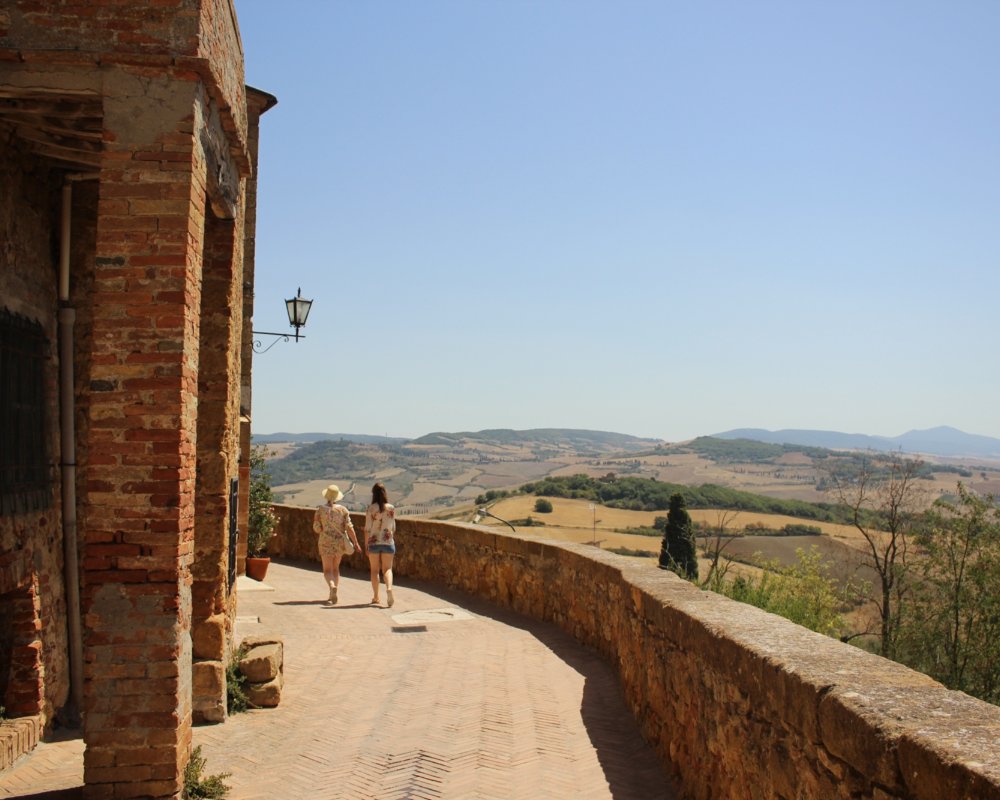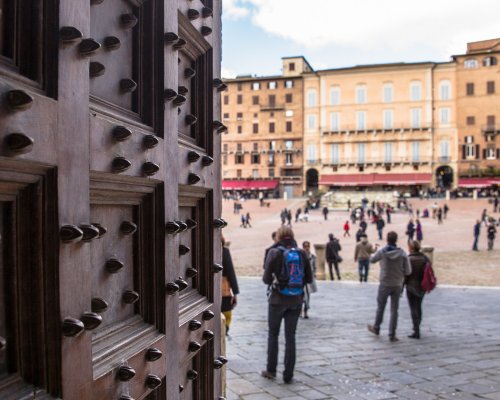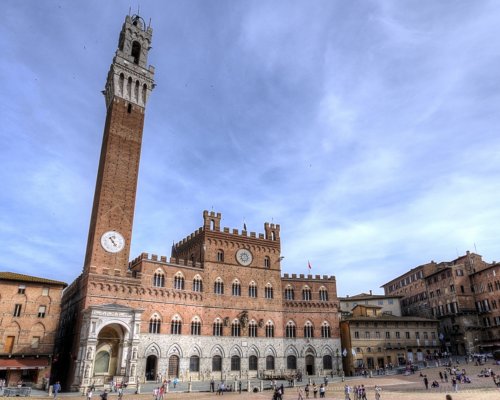Travel suggestions for movie buffs
With jaw-dropping views, alternately opulent and rustic architecture, and pinch-me landscapes, Siena and its surrounding areas have served as the set for numerous films, from action-packed war dramas to romantic classics. For your next trip, take a few cues from film directors and location scouts who knew what they were doing when they swapped studio lots for Tuscan landscapes.
“Campo. Piazza del Campo.”
One of the most jarring sequences in the 007 franchise comes from the 2008 film Quantum of Solace, in which shots from the Palio di Siena are juxtaposed with a harrowing chase scene before characters storm the unsuspecting crowds at the horse race.
Since we suspect you’ll be doing less enemy-dodging and roof-jumping than Daniel Craig, a calmer day in piazza del Campo calls for a visit to the Palazzo Pubblico (town hall), home to the Museo Civico (civic museum). It was constructed largely between the end of the 13th and the first half of the 14th centuries to house Nova government officials, the then-rulers of the Republic of Siena. The original splendor still holds up: magnificent frescoes from Sienese school master Simone Martini define the Sala del Mappamondo, with the Maestà (1315) standing out, while the Sala dei Nove is known for Ambrogio Lorenzetti’s Allegory of Good and Bad Government (1339) cycle. You can get the tickets from this website.
If James Bond and company piqued your Palio curiosity, the bareback races take place on July 2 and August 16 annually in the same square. Note that this is not a particularly tourist-friendly event: it’s a ceremonious celebration of Sienese identity and as such, getting VIP access to the action is never easy check the Comune di Siena website for up-to-date information on seating. The horse races themselves usually last no more than 90 seconds, but the pomp and circumstance is what continues to attract new audiences. Attending the trial runs, which generally take place in the three days preceding the race, is free.
In the afternoon, take a detour from the James Bond journey and walk to the nearby piazza Jacopo della Quercia for a survey of additional key sights, including the spectacular Duomo di Siena; the Facciatone, part of the remains of the unfinished “new cathedral”; and Santa Maria della Scala, a former hospital which now hosts noteworthy exhibitions. Or, make like a sophisticated British Secret Service agent undoubtedly would and splurge on a fine meal: opt for a decadent first course, such as pici al ragù di cinta senese, a type of fat, hand-rolled pasta enhanced with sauce made with native-to-the-area pork.
“Campo. Piazza del Campo.”
One of the most jarring sequences in the 007 franchise comes from the 2008 film Quantum of Solace, in which shots from the Palio di Siena are juxtaposed with a harrowing chase scene before characters storm the unsuspecting crowds at the horse race.
Since we suspect you’ll be doing less enemy-dodging and roof-jumping than Daniel Craig, a calmer day in piazza del Campo calls for a visit to the Palazzo Pubblico (town hall), home to the Museo Civico (civic museum). It was constructed largely between the end of the 13th and the first half of the 14th centuries to house Nova government officials, the then-rulers of the Republic of Siena. The original splendor still holds up: magnificent frescoes from Sienese school master Simone Martini define the Sala del Mappamondo, with the Maestà (1315) standing out, while the Sala dei Nove is known for Ambrogio Lorenzetti’s Allegory of Good and Bad Government (1339) cycle. You can get the tickets from this website.
If James Bond and company piqued your Palio curiosity, the bareback races take place on July 2 and August 16 annually in the same square. Note that this is not a particularly tourist-friendly event: it’s a ceremonious celebration of Sienese identity and as such, getting VIP access to the action is never easy check the Comune di Siena website for up-to-date information on seating. The horse races themselves usually last no more than 90 seconds, but the pomp and circumstance is what continues to attract new audiences. Attending the trial runs, which generally take place in the three days preceding the race, is free.
In the afternoon, take a detour from the James Bond journey and walk to the nearby piazza Jacopo della Quercia for a survey of additional key sights, including the spectacular Duomo di Siena; the Facciatone, part of the remains of the unfinished “new cathedral”; and Santa Maria della Scala, a former hospital which now hosts noteworthy exhibitions. Or, make like a sophisticated British Secret Service agent undoubtedly would and splurge on a fine meal: opt for a decadent first course, such as pici al ragù di cinta senese, a type of fat, hand-rolled pasta enhanced with sauce made with native-to-the-area pork.
Ridley Scott’s colossal drama Gladiator (2000) features several scenes filmed in this dreamy region, with General Maximus’ recurring visions of home nostalgically colored by Val d’Orcia wheat fields and textbook Tuscan scenery. A particularly emotive segment in the film’s final moments (no spoilers!) sees Maximus move along the road connecting the Agriturismo Terrapille (www.terrapille.it) to the Pieve di Corsignano (piazza Dante Alighieri 29, Pienza), a Romanesque church dating to the 12th century.
If you’re not a gung-ho Gladiator fan, there’s no need to go to this specific road, as the scenery is striking everywhere you turn. Rather than following Maximus’ exact footsteps, make the one-hour drive from Siena to Pienza, perhaps stopping off for lunch at San Quirico d’Orcia, a hilltop town worthy of its own Oscar.
Once you set foot in Pienza, take note: this is the definitive blueprint of Renaissance urban planning. The trapezoidal Piazza Pio II—commissioned by Pope Pius II, hence its name—is the city’s capstone, and is featured in Michael Hoffman’s 1999 take on Shakespeare’s A Midsummer Night’s Dream (along with a panoramic view of the Val d’Orcia toward Pienza as the movie’s opening shot). The square’s architect, Bernardo Rossellino, applied the Humanist principles of his mentor, Leon Battista Alberti, in its design.
Standing tall in the square is the Palazzo Piccolomini, which makes an appearance in another adaptation of a Shakespearean classic. Franco Zeffirelli’s Romeo and Juliet (1968) spotlights the Piccolomini courtyard as the setting of the glamorous ball where a masked Romeo makes his first appearance; a later scene unfolds at nighttime between piazza Pio II and Corso Rossellino, the town’s main shopping street.
Staying with the star-crossed lover theme, the big-budget melodrama The English Patient is set during the Italian Campaign of World War II, with several key scenes filmed outside Pienza at the Monastero di Sant’Anna. Once an Olivetan Benedictine monastery, it’s a short 6km drive or bike ride outside the center and now home to an agriturismo (private farmstay).
Ridley Scott’s colossal drama Gladiator (2000) features several scenes filmed in this dreamy region, with General Maximus’ recurring visions of home nostalgically colored by Val d’Orcia wheat fields and textbook Tuscan scenery. A particularly emotive segment in the film’s final moments (no spoilers!) sees Maximus move along the road connecting the Agriturismo Terrapille (www.terrapille.it) to the Pieve di Corsignano (piazza Dante Alighieri 29, Pienza), a Romanesque church dating to the 12th century.
If you’re not a gung-ho Gladiator fan, there’s no need to go to this specific road, as the scenery is striking everywhere you turn. Rather than following Maximus’ exact footsteps, make the one-hour drive from Siena to Pienza, perhaps stopping off for lunch at San Quirico d’Orcia, a hilltop town worthy of its own Oscar.
Once you set foot in Pienza, take note: this is the definitive blueprint of Renaissance urban planning. The trapezoidal Piazza Pio II—commissioned by Pope Pius II, hence its name—is the city’s capstone, and is featured in Michael Hoffman’s 1999 take on Shakespeare’s A Midsummer Night’s Dream (along with a panoramic view of the Val d’Orcia toward Pienza as the movie’s opening shot). The square’s architect, Bernardo Rossellino, applied the Humanist principles of his mentor, Leon Battista Alberti, in its design.
Standing tall in the square is the Palazzo Piccolomini, which makes an appearance in another adaptation of a Shakespearean classic. Franco Zeffirelli’s Romeo and Juliet (1968) spotlights the Piccolomini courtyard as the setting of the glamorous ball where a masked Romeo makes his first appearance; a later scene unfolds at nighttime between piazza Pio II and Corso Rossellino, the town’s main shopping street.
Staying with the star-crossed lover theme, the big-budget melodrama The English Patient is set during the Italian Campaign of World War II, with several key scenes filmed outside Pienza at the Monastero di Sant’Anna. Once an Olivetan Benedictine monastery, it’s a short 6km drive or bike ride outside the center and now home to an agriturismo (private farmstay).
The final “must” on a movie lover’s itinerary through the Siena province is Montepulciano a roughly 20 minute drive from Pienza. Long a mecca for wine aficionados—this is the home of the right-priced red Vino Nobile di Montepulciano—the town has also gained a cult following in fans of the Twilight saga, since the second installment in the series, New Moon, was filmed here.
Piazza Grande, Montepulciano’s moody main square, is the stage for much of the action (and not just in New Moon, either: A Midsummer Night’s Dream, Heaven, the Medici series and others have made use of it in their scripts). A crucial moment in the movie (spoiler alert!) when Bella saves Edward takes place between this suitably haunting setting and the entrance to the Palazzo Comunale. The 15th century facade, designed by Michelozzo and still probably younger than some of the movie’s vampires, bears notable resemblance to Palazzo Vecchio in Florence. Both are seats of their local governments and the similarities were deliberately implemented by Cosimo I de’ Medici.
After some Bella Swan-style wandering through the town’s narrow, cobblestoned streets, indulge in something red and delicious (and no, we don’t mean blood). Take a seat in an area bar with a view and try a ruby red Nobile di Montepulciano, made with at least 70 percent Sangiovese and 30 percent other local grapes.
If you’re a die-hard Twilight fan, numerous local and regional tour associations organize themed outings to all the sights featured in the movie.
And, that’s a wrap!
The final “must” on a movie lover’s itinerary through the Siena province is Montepulciano a roughly 20 minute drive from Pienza. Long a mecca for wine aficionados—this is the home of the right-priced red Vino Nobile di Montepulciano—the town has also gained a cult following in fans of the Twilight saga, since the second installment in the series, New Moon, was filmed here.
Piazza Grande, Montepulciano’s moody main square, is the stage for much of the action (and not just in New Moon, either: A Midsummer Night’s Dream, Heaven, the Medici series and others have made use of it in their scripts). A crucial moment in the movie (spoiler alert!) when Bella saves Edward takes place between this suitably haunting setting and the entrance to the Palazzo Comunale. The 15th century facade, designed by Michelozzo and still probably younger than some of the movie’s vampires, bears notable resemblance to Palazzo Vecchio in Florence. Both are seats of their local governments and the similarities were deliberately implemented by Cosimo I de’ Medici.
After some Bella Swan-style wandering through the town’s narrow, cobblestoned streets, indulge in something red and delicious (and no, we don’t mean blood). Take a seat in an area bar with a view and try a ruby red Nobile di Montepulciano, made with at least 70 percent Sangiovese and 30 percent other local grapes.
If you’re a die-hard Twilight fan, numerous local and regional tour associations organize themed outings to all the sights featured in the movie.
And, that’s a wrap!


